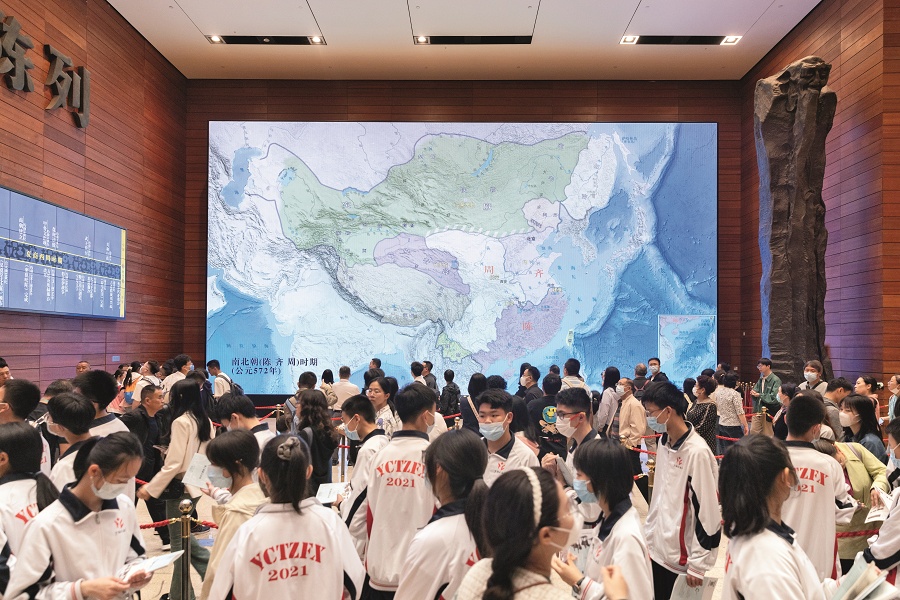Museum Across Time and Space

In May 2023, the National Museum of China (NMC) launched its first original stage play, Joyful Songs in a Flourishing Age, as part of a project seeking to revitalize cultural relics. Inspired by the Pottery Storyteller Beating a Drum, a piece in the NMC’s collection from the Eastern Han Dynasty (25-220), the play presented a fantasy “dialogue” between the cultural relic and the audience while integrating art forms such as drama, musical, opera, dance, and poetry. Dialogues across time and space are happening in new ways at the NMC.
Livening up Cultural Relics
Visitors are often stunned by the bronze exhibits from the Xia, Shang, and Zhou dynasties (2100-256 B.C.) displayed in the “Ancient China” exhibition hall of the NMC, marveling at the wisdom and glory of ancient Chinese civilization. When the NMC acquired a bronze paired yi (a ritual wine vessel) in 1977, it highlighted that one side of the square groove was covered with cracks, and the left edge was partially missing. To assess the overall status of the cultural relic, researchers from the NMC used scientific methods such as X-ray imaging to analyze its historical restoration and rust types, and revealed the chemical composition and distribution of the repair materials and rusts, laying a scientific basis for further protection.
Today, the NMC employs an elite team of experts in detecting, researching, protecting, restoring, and reproducing cultural relics. It protects important Chinese cultural relics with exquisite skills and advanced technologies while inheriting tradition and fostering innovation.

Researchers from the National Museum of China used scientific methods such as X-ray imaging to analyze the best historical restoration path and rust types of a bronze paired yi (a ritual wine vessel). Their work revealed the chemical composition and distribution of the repair materials and rusts, laying a scientific basis for further protection. (Photos courtesy of the National Museum of China)
Creative Cultural Relics
The fun of immersive archaeology and the blessings for global peace radiate from the NMC’s cultural and creative products such as chocolates and incense burners shaped like the Four-Goat Square Zun (wine vessel) and the Haiyan Heqing Zun, respectively. And collectible cards featuring images of the museum’s cultural relics have been quite popular with visitors.
“A museum can move people with rich cultural heritage,” said Zhu Xiaoyun, deputy director of the NMC’s Sales and Development Department. “Cultural and creative products can bridge potential gaps and help visitors relate to hidden culture.”
A kaleidoscope of creative products themed on cultural relics collected in the museum help connect the NMC with the public, kindle cultural memories, and spread Chinese stories.

Tablet inscriptions of an astronomical map in the Southern Song Dynasty (1127-1279) (Photo courtesy of the National Museum of China)
Educational Purposes
“Exhibitions at the NMC helped me understand China’s progress from poverty to prosperity and the ups and downs of the great rejuvenation of the Chinese nation,” said Gong Yuying, a primary school student from Beijing’s Pinggu District. “I am quite confident that China’s future looks rosy.”
The continuous development of China’s public cultural undertakings has inspired museums to meet increasingly diversified and individualized social education needs. “Every citizen in modern society must have certain scientific and cultural knowledge,” said Wang Chunfa, director of the NMC. “Schools are the main contributors in this regard but off-campus education is also gaining momentum, echoing the popular concept of lifelong learning. Museums have become an important channel of off-campus education.”
Previously, an affable museum guide was a central facet of the memories of visitors to the NMC. Today, the museum has formed a diverse social education system integrating offline explanations, smart tour guides, museum-school cooperation, and voluntary services. The NMC is performing like a university, seeking to impart knowledge and inspire wisdom through history.

Visitors gather at the entrance of the “Ancient China” exhibition hall at the National Museum of China, May 5, 2023. (Photo by Chen Jian/China Pictorial)
Digital Development
So far, the NMC has developed 76 virtual exhibition halls, more than 140 themed web pages, and over 50 short videos. Visitors can enjoy cultural relics and boutique exhibitions online, which have helped millions of people taste the charm of Chinese culture without the need to leave their homes.
Since 2018, the NMC has been moving towards construction of a smart museum via cutting-edge information technologies covering fields such as relics protection, management, exhibitions, and other services. By doing so, it seeks to achieve acute perception, ubiquitous interconnection, intelligent integration, autonomous learning, and iterative improvement.
In 2022, the NMC partnered with 33 domestic and foreign museums to launch the program “Treasure Hunt Relay: Global Museum Director’s Choice.” The NMC’s special exhibition under the program presented visitors an immersive experience thanks to digital technology, 8K photography, and a high-definition presentation, allowing them to understand the important role of Chinese characters in Chinese civilization across more than 5,000 years and the exchange and mutual learning among world civilizations.
In the future, the NMC will introduce smart exhibition halls to let visitors witness how its staff collect data on cultural relics and monitor their status to better appreciate the diverse display of cultural relics.